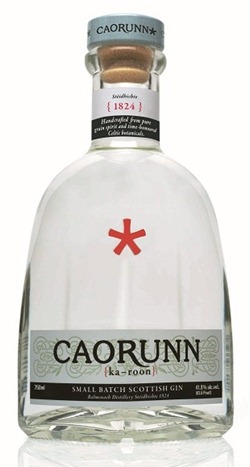 Caorunn Gin (pronounced ka-roon) is a small batch Scottish Gin produced at the Balmenach Distillery in Scotland’s Spey Valley. Caorunn builds on the standard gin botanicals – like juniper berries, coriander seeds, angelica root and citrus peels – with five unique Celtic botanicals. The most prominent is rowan berry, from which Caorunn takes its name (“caorunn” being the Celtic word for the berry). The other Celtic botanicals are bog myrtle, heather, coul blush apple and dandelion leaf.
Caorunn Gin (pronounced ka-roon) is a small batch Scottish Gin produced at the Balmenach Distillery in Scotland’s Spey Valley. Caorunn builds on the standard gin botanicals – like juniper berries, coriander seeds, angelica root and citrus peels – with five unique Celtic botanicals. The most prominent is rowan berry, from which Caorunn takes its name (“caorunn” being the Celtic word for the berry). The other Celtic botanicals are bog myrtle, heather, coul blush apple and dandelion leaf.
In producing Caurunn Gin, neutral grain spirit is vaporized in a 1920s-era copper berry chamber. The botanicals are infused into the spirit, lending their unique flavors and aromatics to the gin. From there, Caorunn is cut with pure Scottish Highland water sourced from the surrounding springs.
All that results in a crisp, dry gin that’s fresh and floral, with lots of citrus and spice on the nose. Take a sip to find flavors of juniper and sweet heather, plus a background of coriander and a fruity component that we’ll assume is rowan berry. It remains very easy to hold on the palate, with a medium-bodied mouthfeel that finishes clean and dry.
Not bad for a whisky-making country. Caorunn’s interesting blend of botanicals lend some fun nuance to the gin, but it’s actually quite traditional in flavor and aroma. If you like London Dry style gins, you’ll probably like Caorunn, though it does play a bit softer than its English cousins.
Caorunn is smooth enough to be sipped straight, but with all gins, it will likely find more use in cocktails. The brand recommends pairing Caorunn with a slice of red apple. We’d second that recommendation, as we just mixed a simple gin and tonic, complete with red apple, to good results.
For now, Caorunn’s availability is limited to the UK and a few select U.S. markets. If you can’t find it near you, consider buying online.
Stats:
– 41.8% Alcohol by Volume
– $35
CE Rating: ★★★★



Oddly, Ohio is one of the select US markets for this gin, fortunately for me. It is a very delicious, but unusual tasting gin.
Interestingly, despite being so unique in flavor, I find it works best in the most traditional of gin usages, like the G&T you mention. But it is most outstanding in a basic Martini. It is less useful in sour or fruity applications, where it’s more unique elements tend to clash a bit.